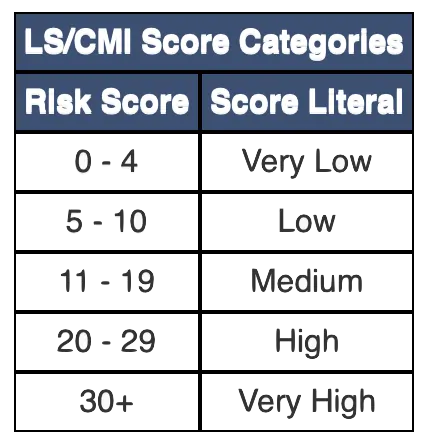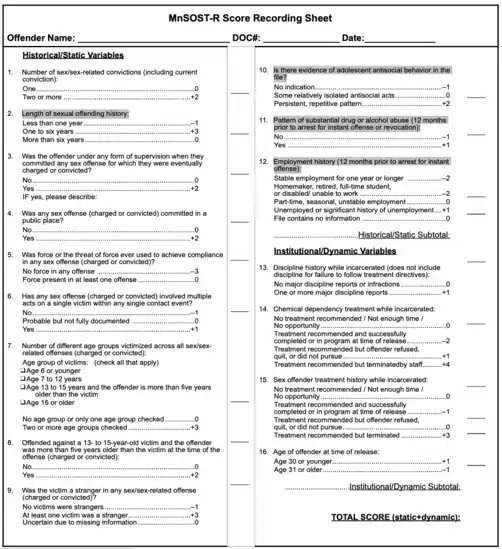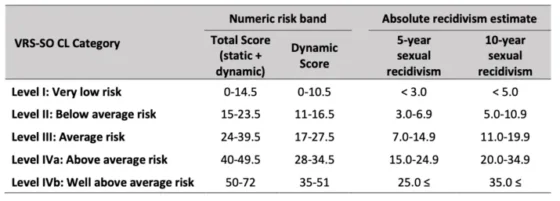Appendix C: Combination Static/Dynamic Risk Assessments
Chapter 4:Psychological Evaluations
Appendix C: Combination Static/Dynamic Risk Assessments
LEVEL OF SERVICE/CASE MANAGEMENT INVENTORY (LS/CMI)
The LS/CMI is used to predict the risk of violent reoffense by sex offenders. It is usually scored by sex offender treatment professionals during probation or parole, and is used to guide treatment decisions while the offender is on parole or probation supervision. It can be used for both female and male offenders. The scores can be interpreted as follows:

MnSOST-R
The Minnesota Sex Offender Screening Tool-Revised (MnSOST-R) is a 16-item actuarial risk assessment tool initially developed for the Minnesota Department of Corrections.[1] It was developed to assess the sexual offense recidivism risk of adult, male, incarcerated sex offenders. The assessment considers both static and dynamic variables, including 12 historical/static items:
- Number of convictions for sex offenses
- Length of sex offending history
- Commission of a sex offense while under court supervision
- Commission of a sex offense in a public place
- Use or threat of force in any sex offense
- Perpetration of multiple sex acts in a single event contact
- Offending against victims from multiple age groups
- Offending against a 13- to 15-year-old victim with more than a 5-year age difference between offender and victim
- Victimization of a stranger
- Persistent pattern of adolescent antisocial behavior
- Recent pattern of substantial substance abuse
- Recent employment history.
As well as 4 institutional/dynamic variables:
- Discipline history
- Chemical dependency treatment recommendations and outcomes
- Sex offender treatment recommendations and outcomes
- Age of the offender at the time of release.
The score for each of these variables ranges from +0 to +4. The Score Recording Sheet indicates the weight of each variable. Self-report is acceptable for the shaded items.

The scores for all of these variables are added up and can be translated into notification levels:

[1] Epperson, D. L., Kaul, J.. D., Goldman, R., Huot, S. J., Hesselton, D. & Alexander, W. (2005) Minnesota Sex Offender Screening Tool Revised (MnSOST-R). MN Department of Corrections.
SVR-20 V2
The SVR-20 is used to evaluate the risk of sexual violence and informing risk management.[2] Unlike actuarial/statistically based tests, the SVR-20 is not limited to the assessment of likelihood of a new offense. Other aspects of risk, such as level of victim harm, victim specificity, frequency, imminence, and likelihood are also measured by this instrument. There are 20 items organized into three subsections with the following item distribution:
- Psychosocial adjustment
- Psychological adjustment
- Sexual deviance
- Victim of child abuse
- Cognitive impairment
- Suicidal/homicidal ideation
- Relationship/employment problems
- Previous offense history (non-sexual violent, non-violent)
- Psychopathy substance use problems and past supervision failure
- Sexual offenses
- High density offenses
- Multiple (types of) offenses
- Physical harm to victims
- Use of weapons/threats of death
- Escalation in frequency or severity of offenses
- Cognitive distortions (extreme minimization or denial of sex offenses)
- Attitudes that support or condone sex offenses
- Future plans
- Lacks future (realistic) plans
- Negative attitudes toward intervention
Each item is coded as absent, possibly or partially present, and present. The assessor may also include “other considerations” unique to each specific case that might be relevant to risk assessment. The assessor also rates whether or not there has been any increase or decrease over time in the risks associated with each factor. The assessor makes the ultimate overall judgment of risk (Low, Moderate, or High), which is meant to reflect the level of intervention required to manage risk in the case.
The SVR-20 has faced criticism due the variability of the extent to which the items are shown to be associated with the probability of recidivistic sexual violence. However, others believe that the factors that are less well established as predictors of recidivism are nonetheless helpful for professionals to assess aspects of risk other than likelihood, such as nature, severity, imminence, and frequency, as well as to develop risk management strategies.
[2] Boer, Hart, Kropp, & Webster (2019). Sexual Violence Risk-20 Version 2 (SVR-20 V2). Reducing Serious Harm; Hart, S. D. & Boer, D. P. (2010). “Structured Professional Judgment Guidelines for Sexual Violence Risk Assessment: The Sexual Violence Risk-20 (SVR-20) and Risk for Sexual Violence Protocol (RSVP)” in Handbook of Violence Risk Assessment, eds. Otto, R. K. & Douglas, K.S. Routledge.; Boer, D. P. (2006). Sexual offender risk assessment strategies: Is there a convergence of opinion yet? Sexual Offender Treatment, 1, 1-4.
VIOLENCE RISK SCALE SEXUAL OFFENSE VERSION (VRS-SO)
The VRS-SO uses both static and dynamic variables to assess sexual offense risk and predict sexual recidivism in adult males.[3] The VRS-SO workbook includes specific instruction for the assessment of men charged only with child pornography related offenses, and recommends not linking the risk levels to recidivism estimates from the normative sample, but the score tallies can be used to identify people’s percentile ranks and treatment targets. The VRS-SO tallies items to generate risk scores, which are then linked to recidivism estimates and risk categories.
The VRS-SO uses a 4-point scale of 0-3 for the following 7 static risk factors:
- Age at time of release
- Age at first sexual offense
- Sexual offense victim profile (child/teen/adult and extra/intrafamilial victims)
- Prior sexual offenses
- Number of unrelated victims
- Number and gender of victims
- Prior sentencing dates
It also considers 17 dynamic risk factors, both before treatment, after treatment, and the change throughout treatment:
- Sexually deviant lifestyle
- Sexual compulsivity
- Offense planning
- Criminal personality
- Cognitive distortions
- Interpersonal aggression
- Emotional control
- Insight
- Substance abuse
- Community support
- Release to high risk situations
- Sexual offending cycle
- Impulsivity
- Compliance with community supervision
- Treatment compliance
- Deviant sexual preference
- Intimacy deficits
The scores relate to common language (CL) categories as follows:

To combine the VRS-SO and Static-99R categories, the following grid can be used:

Without a Static-99R score, the VRS-SO can still be used to generate 5 and 10-year sexual recidivism estimates:

[3] Olver, M., Kelley, S., Johnson, L., & Wong, S. (2020). Violence Risk Scale-Sexual Offense Version (VRS-SO): Users’ Workbook.


